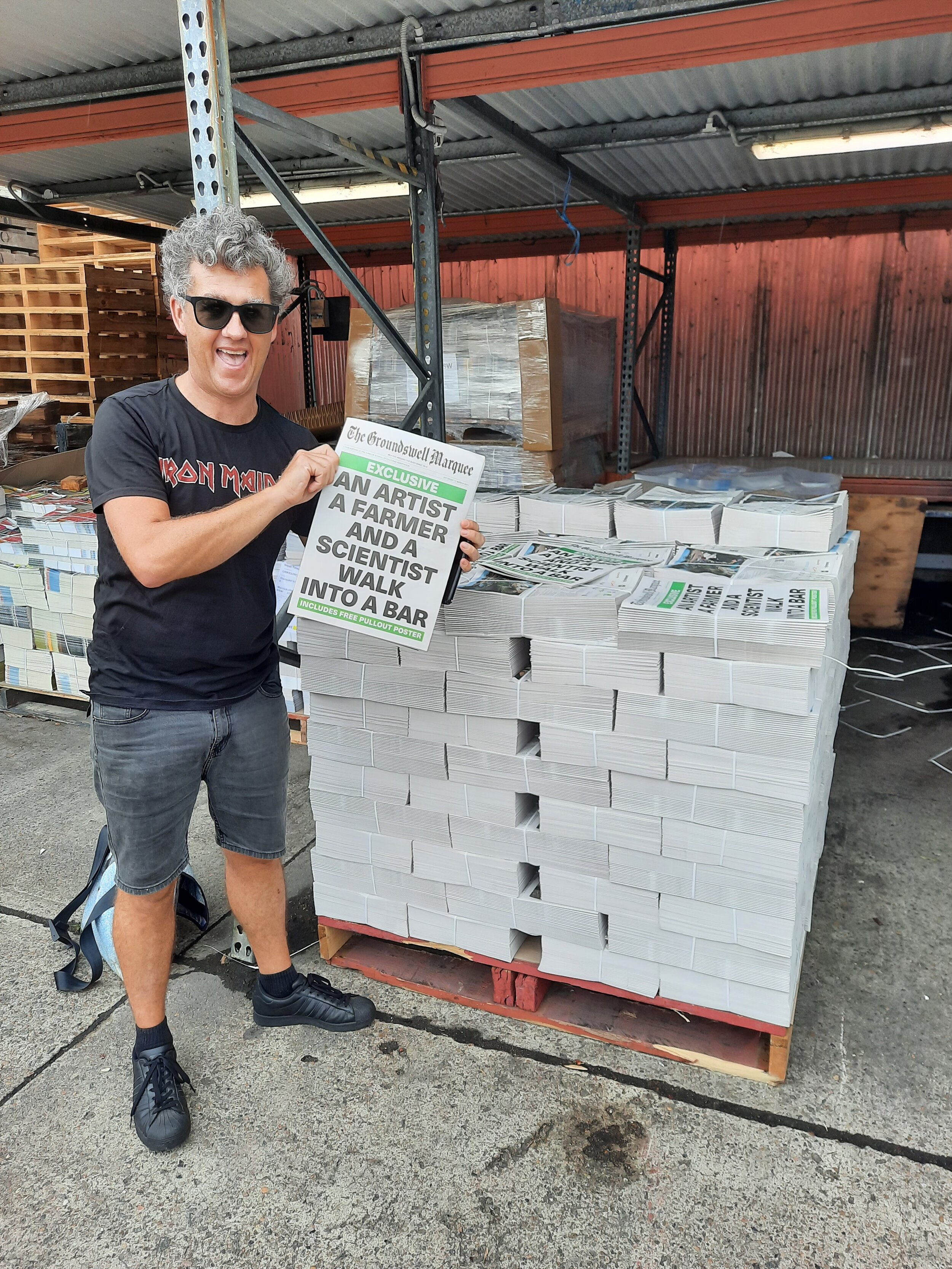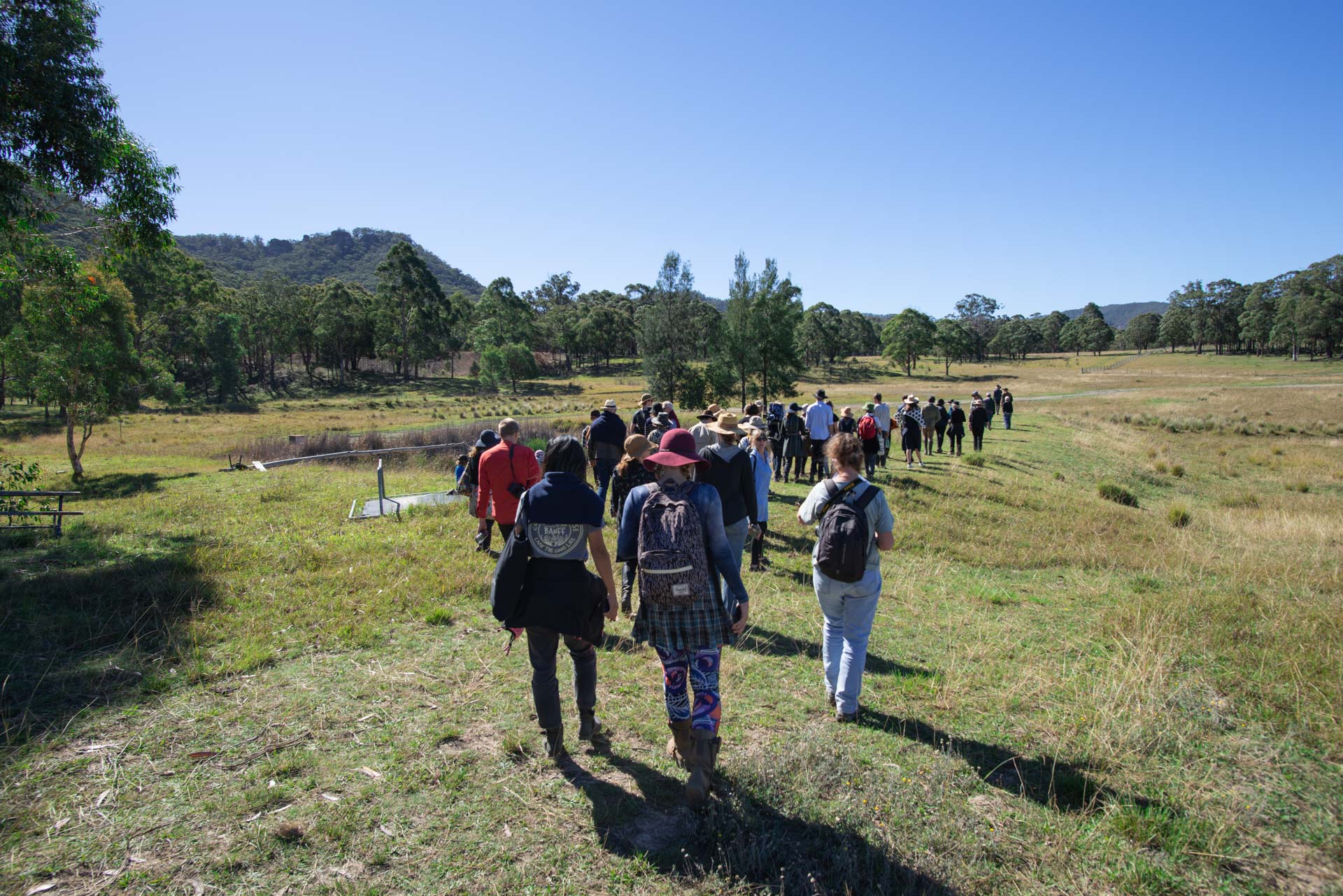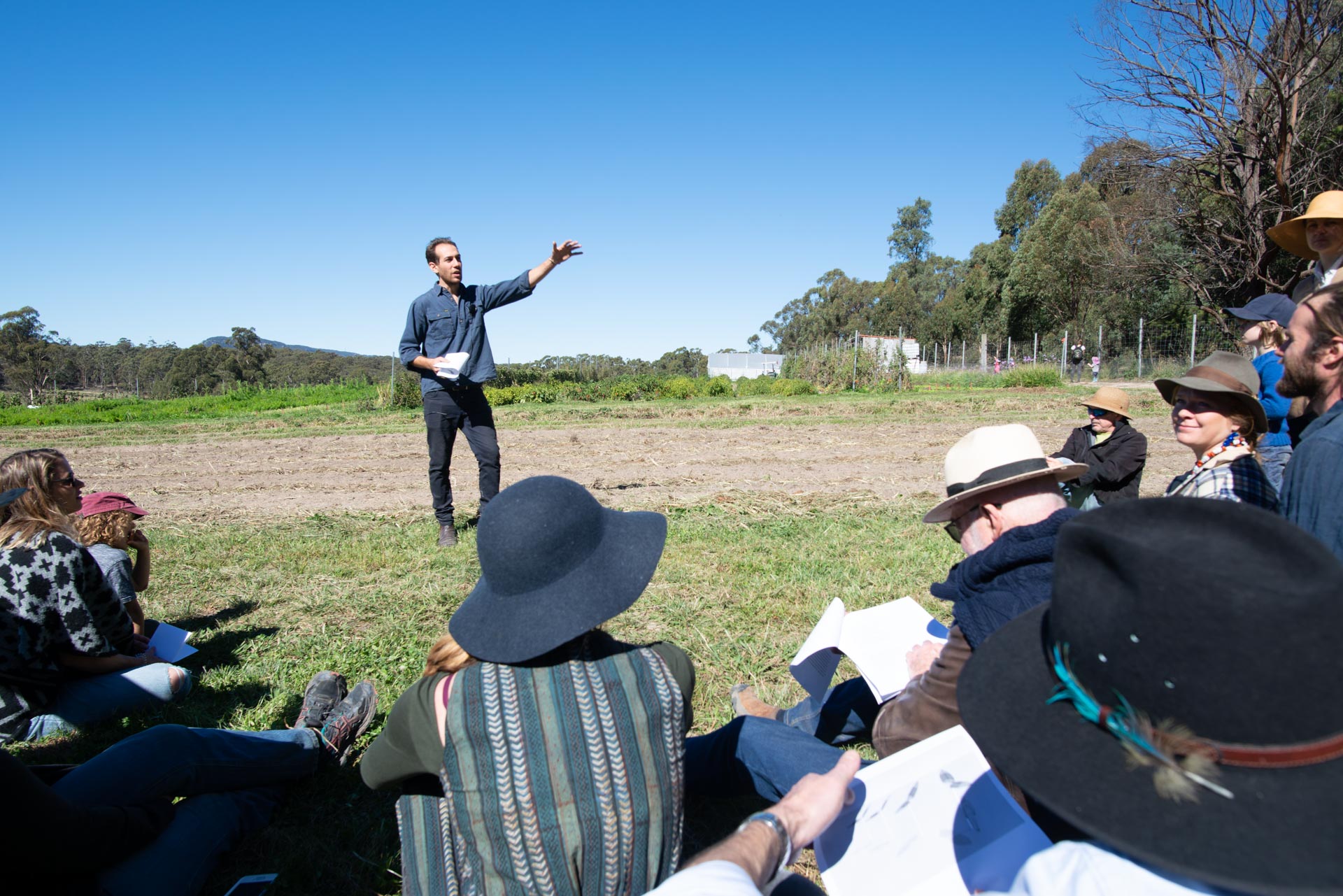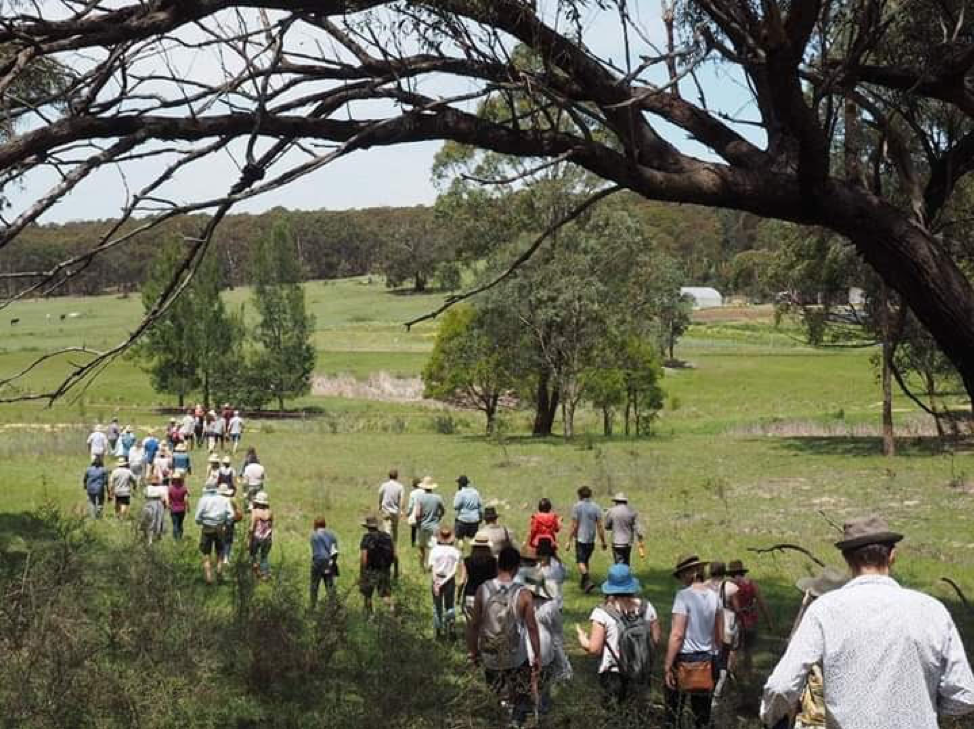It’s 56 pages long, raw and wriggling, and it has a free pull-out poster. We have finally published the newspaper that tells the story of ‘An artist, a farmer and a scientist walk into a bar’, and we’d love to share it with you.
The solar project video
Solar energy on the farm: the voice of the scientist
A picnic, a walk, a scientist, an artist, a farmer, a dam, some cows, a market garden...
By Alex Wisser
It is difficult to decide what was more beautiful, the weather or the landscape as we gathered at Bula Mirri Farm in Hartley, to embark on our Art and Farming tour, picnic and conversation. Like WB Yeats, let us settle on the fact that you cannot tell the dancer from the dance, and the day, like the landscape, like the people gathered, like the food and the conversation, blended into a single experience that was its own whole, generous, warm, fascinating thing. Our sincere gratitude to our hosts Erika Watson and Hayden Druce for their hospitality and the generosity with which they opened their farm, and their experience as farmers up to us.
The day began with an intro from Ian Milliss and a little conversation with Erika and Hayden before we headed off down the dirt road to the Keyline dam that they are building on the property. The principles of Keyline farming originate with farmer/inventor PA Yeomans, who was the subject of a project that was an early antecedent of all that KSCA does now. His work is now part of the dna of the permaculture and regenerative farming movements.
I was blown away by the scale of their ambition. This dam is only half finished, and the funds raised through our event will contribute to its completion.
The story behind this dam includes the story of the severe drought that Australia is now facing. It was the perfect backdrop to understand the scale of the problem and the importance of converting to regenerative farming methods, much of which is predicated on principles of water retention in healthy soil and well managed landscapes.
Our next stop was a small cell grazing operation. Hayden explained how the cattle can be used to improve soil and create nutrient inputs for the market garden that is the main business of the farm. These cattle are not being raised for their meat, but for their ability to improve the soil.
It was at this point that I learned something about our Artist Farmer Scientist project that I had not realised before. Erika and Hayden spoke eloquently of the struggle of farming, the challenges of working under drought conditions to raise enough produce to make a living and to care for the land at the same time. While the picturesque setting and the idealism of their endeavour might have appealed to us day trippers, I imagine that the daily grind and the isolation of farming could get dire. Having talked to enough farmers, you come to understand why depression and suicide are such prevalent issues. Erika and Hayden were able to turn to the idea of art, re-conceiving their work as artistic making, a gesture that would re-energise their project. As KSCA proceeds with our strange project of attempting to engage art in the real world (in this instance, the real world of farming), I have thought about a number of the ways that art can contribute to real world cultural change. Art, for instance, has the capacity change perception, disrupt conventional thinking and to communicate with diverse audiences. But it had not occurred to me that art could play this important role as well. It reminded me that culture, when it is practiced in a manner that is integrated into daily life, can motivate that life with the meaning that it produces, as well as connecting those who practice it together. Seeing this great crowd of people on this farm, keen to overcome the abstraction and detachment through which farming is commonly perceived, was a benefit to the farmer as much as anyone else - connecting them into the society which they fed.
Artist Mark Swartz is seen here speaking in front of the patch of the market garden which has been allocated to ‘the solar garden’ project. He, Erika and Hayden and solar scientist Bjorn Sturmberg, are nutting out how solar-panelled sculptures or ‘trees’ could be installed here. They could function as a ‘storey’, harvesting sunlight to power things like irrigation pumps, while also providing modest shade to other plants.
We finally returned to the marquee and had our picnic. And a pleasant picnic it was, before we returned to the serious business of talking about art and science and farming.
Artist Allan Giddy discussed his long history of working with solar and alternative energy in artworks. He wowed the crowd with his first solar artwork that he made back in 1994, and his recent work Flow. Mark Swartz spoke about the journey he and scientist Bjorn Sturmberg have taken to conceive of a work that would fit within the farming environment. A poignant discussion followed around the challenges of communication. Erika and Hayden spoke of the intensity of feeling farmers experience during drought, how much they care for the land and their livestock. Mark made the salient point that though this was true, farmers were on the whole not very good at communicating this relationship. Erika replied that this was often because the relationship was too big, too complex and overwhelming for words. Mark pointed out that this was exactly why artists could be useful - because we work visually, and conceptually, and are often able to convey complex emotion and ideation in a single intuitive hit.
Allan Giddy demonstrates a solar machine that counts down his mortality. It has been running for several decades.
This conversation was complemented by solar scientist Bjorn Sturmberg’s commentary (Bjorn joined us via skype), which revealed another aspect of our project that had not yet occurred to me. Bjorn spoke about the struggle to conceive of a work that would satisfy the artist’s need for aesthetic presentation, the scientist’s concern with efficiency and the farmer’s need to consider production. It was a fascinating description of the consequences of putting four people from highly specialised disciplines together to create something. The diversity of perspectives was disruptive to each category of knowledge. By asking these individuals to consider an object in common, we were asking them to think of it holistically, as an integrated object that is at once cultural, scientific, and agricultural. This appears as a problem, because most of us are very good at comprehending things in isolation, and completely incompetent at apprehending them as embedded within a complex reality. Was this not the point that Erika and Hayden had raised when they spoke of the need to make farming into a cultural activity?
This is something regenerative farmers have constantly said to us throughout this project: that ecological systems are complex and made more so by human social and cultural systems. How then can we think about them properly, if we insist on reducing them to the simplicity demanded by our conventional means of understanding? Perhaps then we should follow the poet and recognise that there is no distinction between the dancer and the dance.
Nothing left to do, but to keep walking out on the limb we find ourselves on.
Meet Allan Giddy
Making a solar garden
Three solar energy concepts that will surprise and delight...
Mark and Bjorn are developing an on-farm solar energy project with horticulturalists Erika Watson and Hayden Druce of Epicurean Harvest (in Hartley). After meeting on the farm the four of them have exchanged some exciting ideas via email which we really needed to share with the world… In this post we have included some pictures from Epicurean Harvest’s November ‘I’ll be damned! farm resilience’ fundraiser event, when they opened their gates to a couple of hundred people who were treated to food, tours, music and talks. As a result they are well on their way to being able to fund the installation of some P.A. Yeomans-style keyline water conservation and irrigation infrastructure on their farm in 2019. Brilliant.
This is Erika
Email 1 - Mark writes…
…We are keen to start throwing some ideas back and forth with some of the concepts we were talking about on our visit. Ideas around how to be more creative in re-thinking the ways we move water around a property and what unconventional ways we can use energy that is self sufficient. And of course how to make it look amazing!
In our meeting we went down a few paths not limited to solar powered little buggies that transport hose and pump water around the paddock. We discussed the ideas of retractable dam covers and floating solar. We played with the concept of the whole farm being one big energy producing entity and how to relate that concept into an artwork.
Let us know some of your thoughts, also if you'd still like to work with us on this? Where you'd like to see it go and how it can benefit the farm?
Email 2: Erika writes…
…Our ideas are obviously coming from our own context, but applicable to the exciting movement happening in the agricultural space. We are also 2 people with science degrees and creative backgrounds (Hayden music, me painting).
After you visited we went though in more detail the ideas we had thrown out there in the initial email. With a bit of space we have had more thoughts on those and the applicable nature for wider uptake as an artistically beautiful and agriculturally functional piece of solar science.
Below I have fleshed out thoughts/concepts more, and knowing you don't have a trillion dollar budget, aimed high with the idea of concepts translated into more financially achievable outcomes.
Floating Panels:
We discussed the dam and water (obviously our biggest issue and ongoing threat to livelihood). We aim to have the dam in place/built by February. If the panels went over this, we were thinking instead of floating it would be better to be a shelter. Floating as we mentioned would block air flow and light to the dam, affecting biology, also the surface would fluctuate with rainfall or use and perhaps be problematic for panels resting in the water’s surface. A structure built over the dam or part of the dam, perhaps to look like carved tree trunks or woven from materials (thinking of your bamboo Mark, but perhaps would need to be in metal in the dam then to wood if needed and the garden by the bay in Singapore), panels as leaves/canopy. Functionally this would reduce evaporation, still allow light through for dam life, and contribute to farm power needs. The tree/s a direct relationship to real trees/plants, photosynthesis and power of solar energy. The trees that were in the water (ie "planted" at the bottom of the dam), would have to go in, at least in part, before it filled up... its highly unlikely we would empty it to do the project, I'm sure you totally understand that! This sounds epic, Hahaha! But thought I'd flesh out what I can see on this end. This would be beneficial to our farm and dam project, but also to many farmers, who look to bore/groundwater as a source of irrigation as it doesn't evaporate... until you use it. We don't want to use groundwater, water in the ground/soil is the best place for it to be! Taking it up, throws it into the atmosphere, and moves it into the different water cycles around the planet. Water vapour contributes to 60-85% of the greenhouse effect. Workshops/engagements could be on photosythesis and photovoltaics, water cycles, carving, weaving, structural integrity...
Solar Powered Buggy:
We move cows/livestock almost daily or sometimes faster (depends on pasture quality etc) to enable grass to grow, and exudates to pour into the soil, improving organic matter. Many farmers moving towards regenerative agriculture do this, and a big blockage for uptake of these methods is the labour involved. That of carrying and moving fencing and watering infrastructure. An amazing designed "buggy" that holds and moves an IBC (1000L) of water, a water trough, stores fencing equipment (lightweight) and acts as a remote energiser for the fencing would be AMAZING. Obviously powered by solar. It would be super cool if it was remote controlled. This would suit pastured poultry, small herds of livestock suck as goats, sheep and even cows. This concept would have to be upscaled to apply to larger farmers with larger numbers of livestock. As an artwork, it would be up to design to translate the multifunctional coolness of something like this (i'm kinda seeing some sort of kinetic sculpture, even steam punk thing or a even streamline and sleek, or totally made of recycled materials to translate ease of uptake). Solar energy of course feeding the freedom of regenerative farming. Workshops/engagements can be on art as kinetic multifunctional use, solar energy, animals are part of a sustainable landscape...
Whole Farm Solar Energy:
I had the idea of what I was calling ribbons on the contour. Below the drainages cut for the dam (on contour), this is where forestry can take place and watered passively but instead of planting trees (a time vs wow factor to consider), a landscape sculpture that, like contour forestry, is below the dam drainage contours, built as a long tube (perhaps only needs to be 30cm tall?), woven out of logs, sticks, branches, filled with composted/ing materials and seed bombs of grasses, herbs, forbs, etc, faster growers than trees (which can also go in, but later in succession – also an important concept in regenerative farming). Increasing the biodiversity, solar harvest and a whole farm approach to sculpture. Workshops/engagements can be on biodiversity and ecosystem processes, photosynthesis and solar, sculpture across landscape...
This is Hayden
Email 3: Mark writes…
Erika! Awesome.
Floating Panels:
This is cool, bamboo would be great for the canopy, but it doesn’t do so well in direct sunlight for long. I’ve attached a photo of a project I did in Larjamanu where we wove disused aluminium cables from power lines. I can’t stop thinking Kinetic sculpture and maybe the solar power lowers the canopy in during the sunniest times of the day and opens it back up later when the sun goes away. Also floating barges are relatively simple to make, and don’t need to cover the whole space but might just float about. Plus they make really interesting platforms for sculptural work.
Solar powered Buggy.
The more I think about this the more I feel like farmers are just going to be like, well why not just put the IBC on a trailer and tow it around. Also it keeps on feeling like a ‘start up’ idea rather than a creative project. What do you guys think? BUT there are still creative solutions to this problem that would be really fun to play with. These sprinkler tractors https://www.youtube.com/watch?v=eTsEzqwjS0I (video complete with inspiring music) I was talking about in our meeting the other day, I’m thinking of as a fun model to scale up… not sure yet how useful it would be but it would be fun.
Whole Farm Solar.
Yeah this is great, this to me is a great spot to use woven bamboo, and let it naturally decompose once the growth around it gets thick enough.
Your enthusiasm is awesome and its contagious!
Lets keep chatting!
Email 4: Bjorn writes…
My thoughts at the moment are that the solar over dam idea sounds most practical. I really love the buggies, but agree it's kinda #startup. Floating solar is generally seen as a pain not worth the effort in the industry, so using the space of the dam without using floats and while respecting the solar requirements of the water would be really neat.
Looking forward to see where we can go with the next development!

































